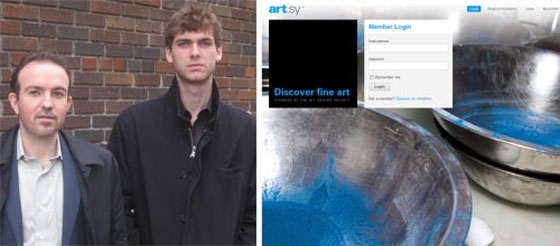
Art.sy developers Sebastian Cwilich, left, and Carter Cleveland right. Image via: The Art Newspaper
Art.sy, a new online art database that uses the genome technology of Pandora to make suggestions based on the shared characteristics of art works launches this week, and they’ve revealed their pricing model. It’s really strange. As reported by The Art Newspaper:
Rather than pay a subscription fee, participating galleries are asked to pay Art.sy a sales commission: 15% of the first $10,000 profit (the amount remaining once the dealer has paid the artist’s share and production costs), and 10% of anything above that. As sales are conducted off-site, Art.sy is reliant on the honesty of the participating galleries.
I have a few concerns about this as a profit model. Lower East Side dealer James Fuentes says it’s not much different than the standard practice of offering a commission to an art advisor, but I don’t buy that. In addition to offering a good eye and research, consultants often do the price negotiating for their clients, which means they have a personal relationships with both the buyer and seller. It’s a little harder for software to form those same kinds of connections, particularly if all sales occur off-line. Add to this that most dealers I know already complain that most consultants are unnecessary and cut into their profits, and the potential for unreported sales is very high.
Still, 15% of a multimillion dollar sale would likely out perform any subscription model given the current size of the market likely to use the site, so it’s not difficult to see the allure of this pricing structure. It will be interesting to see what encouragement Art.sy developers have built into the site to get people to report the sales. The site launches this week at the Basel Art Fair, so we’ll know soon enough what those incentives are – and if they even exist.
UPDATE: Art.sy’s Carter Cleveland responds:
Art.sy’s goal is to establish value in the art world ecosystem. We want to be a resource for new and established collectors to discover art and think about it in new ways – driving sales for our commercial partners by expanding their client base. The “handshake” business model was not chosen for its robustness, but rather because it is risk-free for our gallery partners and a model they are familiar with from working with art advisors. But, of course, our business model will evolve and change over time. In the long-run, if we can become a go-to resource for finding art online, we are confident that there will be a way to fulfill our goal of making the art world more accessible while also being a sustainable business.
I’m not sure Cleveland’s said much of anything here, though there is a hint here that the company may start charging after its client base is established.


Comments on this entry are closed.